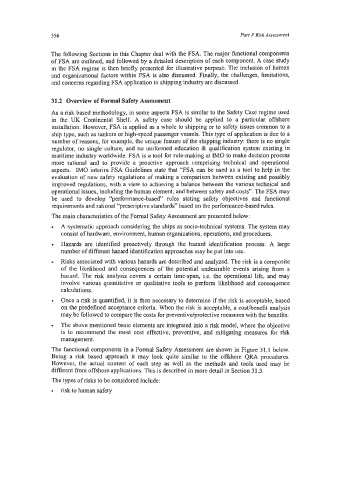Page 580 - Marine Structural Design
P. 580
556 Part V Risk Assessment
The following Sections in this Chapter deal with the FSA. The major fhctional components
of FSA are outlined, and followed by a detailed description of each component. A case study
in the FSA regime is then briefly presented for illustrative purpose. The inclusion of human
and organizational factors within FSA is also discussed. Finally, the challenges, limitations,
and concerns regarding FSA application in shipping industry are discussed.
31.2 Overview of Formal Safety Assessment
As a risk based methodology, in some aspects FSA is similar to the Safety Case regime used
in the UK Continental Shelf. A safety case should be applied to a particular offshore
installation. However, FSA is applied as a whole to shipping or to safety issues common to a
ship type, such as tankers or high-speed passenger vessels. This type of application is due to a
number of reasons, for example, the unique feature of the shipping industry: there is no single
regulator, no single culture, and no uniformed education & qualification system existing in
maritime industry worldwide. FSA is a tool for rule-making at IMO to make decision process
more rational and to provide a proactive approach comprising technical and operational
aspects. IMO interim FSA Guidelines state that “FSA can be used as a tool to help in the
evaluation of new safety regulations of making a comparison between existing and possibly
improved regulations, with a view to achieving a balance between the various technical and
operational issues, including the human element, and between safety and costs”. The FSA may
be used to develop “performance-based” rules stating safety objectives and functional
requirements and rational “prescriptive standards” based on the performance-based rules.
The main characteristics of the Formal Safety Assessment are presented below:
A systematic approach considering the ships as socio-technical systems. The system may
consist of hardware, environment, human organizations, operations, and procedures.
Hazards are identified proactively through the hazard identification process. A large
number of different hazard identification approaches may be put into use.
Risks associated with various hazards are described and analyzed. The risk is a composite
of the likelihood and consequences of the potential undesirable events arising from a
hazard. The risk analysis covers a certain time-span, i.e. the operational life, and may
involve various quantitative or qualitative tools to perform likelihood and consequence
calculations.
Once a risk is quantified, it is then necessary to determine if the risk is acceptable, based
on the predefined acceptance criteria. When the risk is acceptable, a costhenefit analysis
may be followed to compare the costs for preventive/protective measures with the benefits.
The above mentioned basic elements are integrated into a risk model, where the objective
is to recommend the most cost effective, preventive, and mitigating measures for risk
management.
The fiinctional components in a Formal Safety Assessment are shown in Figure 31.1 below.
Being a risk based approach it may look quite similar to the offshore QRA procedures.
However, the actual content of each step as well as the methods and tools used may be
different from offshore applications. This is described in more detail in Section 3 1.3.
The types of risks to be considered include:
risk to human safety

